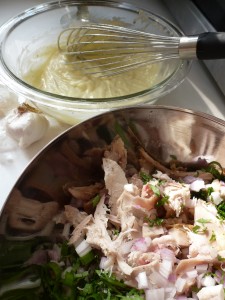 I am very interested in foods that I only knew in their industrial form for decades before I understood what they actually were. Mayonnaise may be the supreme example. It was a ubiquitous component of my childhood. I’ve written about this before, but I sat at many family suppers that featured three different mayo-based salads side by side by side, what I call the holy trinity of Ontarian side dishes: cabbage salad, macaroni salad, and potato salad.[1]
I am very interested in foods that I only knew in their industrial form for decades before I understood what they actually were. Mayonnaise may be the supreme example. It was a ubiquitous component of my childhood. I’ve written about this before, but I sat at many family suppers that featured three different mayo-based salads side by side by side, what I call the holy trinity of Ontarian side dishes: cabbage salad, macaroni salad, and potato salad.[1]
Mayonnaise was such a ubiquitous part of my youth it wasn’t until my mid twenties that it even occurred to me that mayonnaise must be made out of components.
So, what is mayonnaise? Mayonnaise is a sauce, an emulsion of oil and water, flavoured with acid such as lemon or vinegar.
Oil and water don’t normally mix. We know this. I’ve been told this is because water molecules cohere to each other much better than they adhere to oil. Oil is equally stubborn and coheres to its lipidious brethren before aqueous elements. So when you mix the two, the oil floats on top, the water sinks to the bottom. We know this.
Enter the egg yolk: the reconciler, the bridge. The pontifex.
One yolk easily emulsifies a cup of oil. Actually it is able to emulsify a heck of a lot more than that, but I’m a sucker for a simple recipe.
Salt and acid, often lemon, though I prefer vinegar.
For me mayonnaise definitely makes the list of foods that I will never buy again, (or at least until I become very elderly and immuno-compromised.) Why? Because I always have eggs in the fridge and a big jug of canola oil by the stove. And because for the amount of mayonnaise that I consume, I can make a batch in basically the same time it takes to find the mayo aisle in a grocery store. That sounds like I’m bragging, but it really is that quick.
Mayonnaise
Ingredients
- 1 egg yolk
- roughly 2 tbsp apple cider vinegar (or strained lemon juice if you must)
- 240 mL canola oil
- roughly 60 mL warm water
- salt
Procedure
- Put a damp cloth on your kitchen counter. Rest a heavy glass bowl on top. The moist cloth and heavy bowl will allow you to whisk with one hand and pour oil with the other without the bowl sliding around the counter.
- Put the egg yolk and vinegar in the bowl. Whisk until thoroughly combined.
- Slowly (slowly!) add a few drops of oil to the yolk mixture while whisking. Whisk a few seconds then add a few more drops. Repeat until the yolk mixture starts to thicken.
- Once the yolk mixture has visible thickened, you can add the oil while whisking at a slow drizzle.
- At some point the mixture will become very thick and stodgy. Add a splash of the warm water to loosen.
- Taste. Add salt and adjust acidity and water content as desired.
Yield: a bit more than a cup of Mayonnaise
Saving a Split Mayonnaise
Breaking a mayonnaise is one of the most embarrassing things that can happen to a man. Just kidding. It happens to everyone from time to time, including me. You can tell when mayo is split when it becomes slack and pourable even though a good amount of oil has been added. Also the surface of the sauce will be covered in visible spots of oil, instead of being smooth and opaque. This happens when oil is added to quickly and the egg yolk doesn’t have a chance to properly incorporate the fat with the water.
Fear not: a split mayo can be saved. The trick is to treat your broken mayonnaise as if it were the oil content of an entirely new batch. Grab some more egg yolks, whisk them with a touch more vinegar, then slowly (slowly!) start whisking your broken mayo into the mixture. Go slower this time.
Footnotes
- While I loved these mayo-heavy preparations throughout my childhood, in my twenties I rebelled against the tradition. In Austria I was introduced to krautsalat and erdäpfelsalat that were dressed with vinaigrette-style dressings, heavy on vinegar and mustard. These ultimately won me over and are the basis for my current interpretations of slaw and potato salad.